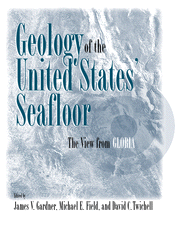Book contents
- Frontmatter
- Contents
- Contributors
- Foreword
- Introduction
- Part I The GLORIA System and Data Processing
- Part II U. S. East Coast EEZ
- Part III Gulf of Mexico and Caribbean EEZ
- Part IV U. S. West Coast EEZ
- Introduction
- 10 Discrimination of Fluid Seeps on the Convergent Oregon Continental Margin with GLORIA Imagery
- 11 A Meandering Channel at the Base of the Gorda Escarpment
- 12 The Morphology, Processes, and Evolution of Monterey Fan: A Revisit
- 13 Ground-Truth Studies of West Coast and Gulf of Mexico Submarine Fans
- 14 Morphology of Small Submarine Fans, Inner California Continental Borderland
- Part V Alaskan EEZ
- Index
10 - Discrimination of Fluid Seeps on the Convergent Oregon Continental Margin with GLORIA Imagery
Published online by Cambridge University Press: 25 January 2010
- Frontmatter
- Contents
- Contributors
- Foreword
- Introduction
- Part I The GLORIA System and Data Processing
- Part II U. S. East Coast EEZ
- Part III Gulf of Mexico and Caribbean EEZ
- Part IV U. S. West Coast EEZ
- Introduction
- 10 Discrimination of Fluid Seeps on the Convergent Oregon Continental Margin with GLORIA Imagery
- 11 A Meandering Channel at the Base of the Gorda Escarpment
- 12 The Morphology, Processes, and Evolution of Monterey Fan: A Revisit
- 13 Ground-Truth Studies of West Coast and Gulf of Mexico Submarine Fans
- 14 Morphology of Small Submarine Fans, Inner California Continental Borderland
- Part V Alaskan EEZ
- Index
Summary
Abstract
Diagenetic carbonate cements and gas hydrates occur at or near the seafloor where pore fluids seep from continental margins. Because these deposits have acoustic impedances that differ significantly from those of hemipelagic deposits, they can be mapped with sidescan sonar if topographic effects (that affect backscattering angle and amplitude) are removed. We have made this topographic correction, using registered GLORIA and SeaBeam data, for a portion of the Oregon continental slope. Comparison of the processed images with local structure indicates that focused fluid expulsion is controlled by faults, but not all faults are active flow paths. Incipient thrust faults in Cascadia Basin just seaward of the base of the slope and an out-of-sequence thrust fault in the Pliocene section of the lower slope apparently channel fluids rapidly to the surface. Near-surface gas hydrates are inferred in the former location and known to precipitate very near the seafloor in the latter. In contrast, the frontal thrust fault that dips landward to the décollement at the toe of the slope shows no evidence of diagenesis associated with focused fluid flow. Instead, pore waters at the décollement may laterally migrate in this region to transverse strike-slip faults that define the northern and southern boundaries of the frontal thrust sheet. Preliminary flow measurements at vent sites, hydrogeologic tests, and thermal anomalies at Ocean Drilling Program (ODP) Site 892 suggest that near-surface formation of gas hydrates is associated with active, rapid fluid discharge. Carbonate cements may reflect slower seepage or relict deposits.
- Type
- Chapter
- Information
- Geology of the United States' SeafloorThe View from GLORIA, pp. 169 - 180Publisher: Cambridge University PressPrint publication year: 1996



